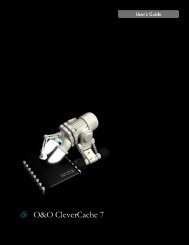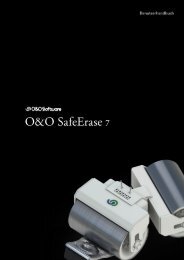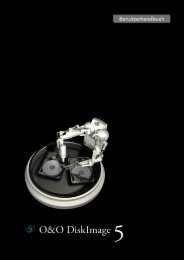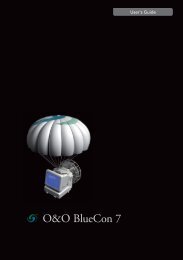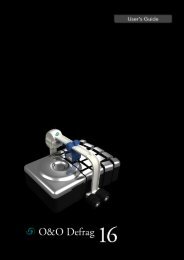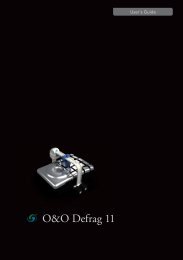O&O DiskImage 7 User's Guide - O&O Software
O&O DiskImage 7 User's Guide - O&O Software
O&O DiskImage 7 User's Guide - O&O Software
You also want an ePaper? Increase the reach of your titles
YUMPU automatically turns print PDFs into web optimized ePapers that Google loves.
Quick Start<br />
6. Check the drives you want to restore from the image. If you want to restore your entire computer, check all<br />
drives.<br />
7. Then select the target drive or disk that should be overwritten with data from the image.*<br />
8. Click the Start drive restoration symbol to start the restoration process.<br />
9. After restoration is successful, you can restart your computer.<br />
*Note: Keep in mind when selecting the target drive that in Windows PE as of Windows Vista, drive letters are different:<br />
Drive C: (normaly containing the non-active operating system) will be assigned another letter (for example<br />
D).<br />
Restore drives<br />
To restore one or more drives from an image, proceed as follows:<br />
1. If you want to restore one or more drives from an existing image, click Drive restoration on the O&O"Restore<br />
drives" <strong>DiskImage</strong> start page.<br />
2. Select the image you want to restore in the DropDown list of Select image. If the proposed images (*.obk) are<br />
not the ones you want to restore, check your drives and enter the path to the image file.<br />
3. Select the image file (*.omg or *.vhd) from the browser and click on Open.<br />
4. All drives contained in the image will then be displayed.<br />
5. Click the drive that you want to restore ("play back").<br />
6. Then, select the target drive for restoration by checking the box next to it. You can either replace an existing<br />
drive or create a new one: for example, in an empty sector.<br />
7. Optionally, you can specify further settings for the restoration under Restoration options.<br />
8. Whenever you have specified all settings, click on Start drive restoration to start the restoration.<br />
Important: During restoration, the image overwrites your selected drive with the data of the drive contained within<br />
the image. All data saved on the target drive is thereby lost and replaced by that of the image.<br />
Note: If your image is split among various disks, all these disks will be required for a restoration. If you have created<br />
an incremental image, all images - from the last complete image to the last incremental image - will be needed.<br />
Note: If you have a imaged an entire hard disk and the restoration is run on a different hard disks, then the new hard<br />
disk must possess at least as much space capacity as the source hard disk.<br />
Note:If you want to restore an entire system or system partition, you'll need to start your computer with the O&O<br />
<strong>DiskImage</strong> bootable medium and perform the restoration from there, seeStart directly from bootable disk. If you<br />
should run a restoration of the system partition to different hardware, read chapter: Restoration on different hardware.<br />
O&O <strong>DiskImage</strong>-24



